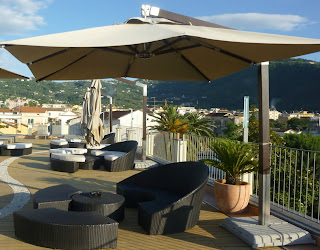I decided to work on the "Try This" exercises from
White Space is Not Your Enemy (2010) on page 56, #3. I looked around and found that I had a ton of GQ magazines lying around that I have never looked at before. After turning through at least 30 ads, I finally got to the cover story. This story was in the August 2011 edition, featuring Mila Kunis. This was the layout for her story:
This layout really "worked" as I analyzed it. According to Golombisky & Hagen (2010), I used their principles and elements to analyze this layout.
Elements
Space: In this layout, negative space is used. I think this is excellent because it really puts an emphasis on Mila Kunis- since the story is about her.
Line: I didn't notice this until I read their description of lines. If you notice how the columns are shaped in a vertical manner and then look at her legs- they resemble each other. The columns of the article resemble her long, luscious legs.
Shape & Texture: I grouped these elements together because my description was relevant for both. The shape of her body here is somewhat geometric. Her long body and the columns, represent rectangles. But, if you look closely, her body is almost as if it is a 3-D image popping out at us. Her legs are shining and you can see the mini shadow of her body in the background.
Size: The size of the article has about an 11 point font, which is very reasonable and easy to read.
Pattern: Each of the questions the interviewer is bold and her answers are in regular font.
I really like how there are both dark and light tones. The light tones being the negative space and the dark tones being her features- eyes, hair, darker skin, and darker undergarments.
Principles
Focal Point: The layout has one focal point and that is the picture of Mila Kunis. The eyes know where to look and what the story is about. The focal point stands out because it is in the negative space.
Contrast: There is a light, white background and her body and picture represent darker images that make her features stand out.
Balance: Her portrait is centered and both the article and picture hold even visual weight since there is no background behind her, in which case then her side would hold more weight.
Movement: The font makes the eyes move across the page and you can see her picture which directly tells the viewer who they are reading about.
Rhythm: The visual has vertical columns, which are in rhythm with her legs. Both vertical columns, that are separated by white space.
Perspective: There is a shorter distance between the picture and the viewer because there is a horizontal line at the bottom of the picture and the darker colors used in this picture.
Unity: There is a whole lot of unity in this layout. First of all, the tan and beige colors being used. Her tan shirt, tan coffee, tan shoes and tan floor are all in unison. Then, her dark black eyes, undergarments, and the font are all in unison. Even the half pink and half beige circle are in unison with her tan skin color and shirt.
For the second part, I looked at the magazine and I found a popular ad that I think really works. According to Golombisky & Hagen (2010), I used their principles and elements to analyze this layout.
Elements
Space: The picture is in negative space, but there is also water pouring down so there is not too much of negative space, but the perfect amount.
Line: The water is pouring down in a diagonal line that directs your attention to the bottle of cologne.
Shape & Texture: The shape is geometric and 3-D because you can see the sides of the bottle, which gives it a standing out effect to the eye. The pouring water also gives a stand out effect.
Value: The light and dark tones give this picture value. The darkest tone is of the focal point- bottle of cologne- and the light tones come pouring down on it, directing attention to the object being displayed.
Size: The size of the picture fits perfectly into this layout. The headline is bigger than the other text, and the name of the cologne resembles the actual picture (Aqua- water). However, this ad uses all caps and centering- SIN!
Pattern: There is a constant pattern of water flowing onto the bottle of cologne.
Principles
Focal Point: One focal point- the bottle of cologne in the center of the layout.
Contrast: Light background, with a darker blue bottle in the center, where the water is pouring down on it.
Balance: The picture is centered, but not asymmetrical because of the water pouring down. The water is pouring down from only one side, so if it were to be cut in half, it would not be a mirror image. However, I think this ad does an awesome job of having the water pouring down in the direction of bringing all of the attention onto the bottle of cologne.
Movement: There is a lot of movement in this ad. The water is flowing down into the direction of the cologne bottle. The movement also represents the name of the product- Aqua.
Rhythm: There is what appears to be a repeated motion of water flowing down onto the bottle.
Perspective: There is a shorter distance in this picture too- There is a lower horizontal line, which makes the viewer closer to the image.
Unity: There is a lot of unity in this picture. The colors of white and blue are in unison with the name of the product- Aqua. There is also water pouring down, which also represents the cologne's name.
Before doing this exercise, I never really analyzed an ad in a high end magazine. I know now what makes an ad appealing and how it appeals to the eye. There needs to be a focal point so the eye knows where to look and what the ad or story is about. Furthermore, I never noticed the contrast between dark and light colors, which was extremely evident in these two pictures. There was unity in both that really added to the way it captured my eye. I will take these examples and the examples from the book and apply it to my own personal stories or websites I will create.
Reference:
 From a designer's perspective, I think four aspects are extremely important: 1) having a celebrity icon (again- personal opinions aside, he is a celebrity), 2) the color of the commercial, 3) the song chosen, and 4) the happy and classy faces of the actors/actresses. People who idolize P. Diddy or even enjoy his songs, would definitely take into consideration that he drinks this vodka. I definitely had to think about Ciroc and how it tastes- what makes it attract celebrities. Also, I think the black and white color adds the Old Hollywood effect in that it portrays this classy, lavish, and respectable lifestyle. If you drink Ciroc, you are celebrating in the classy way. The song chosen is by Frank Sinatra, who is also a huge icon. "Come Fly with Me" is a very popular song, which would attract people who enjoy this song. I also thought how can this song and this vodka be related? This song makes me feel calm and enjoy life- which is something that I also got from this vodka. Also, I've recently noticed how P. Diddy is wearing a bow tie and I found this picture of Frank Sinatra who is also wearing a bow tie. Coincidence? Or is it that the designers wanted the men to dress like this to resemble Old Hollywood and the classy icons? The people in this video are dressed very professionally and classy- tuxedos and long, elegant dresses. These people are also so happy and glowing. They look as if they are celebrating something by drinking this vodka and they are enjoying every minute of it.
From a designer's perspective, I think four aspects are extremely important: 1) having a celebrity icon (again- personal opinions aside, he is a celebrity), 2) the color of the commercial, 3) the song chosen, and 4) the happy and classy faces of the actors/actresses. People who idolize P. Diddy or even enjoy his songs, would definitely take into consideration that he drinks this vodka. I definitely had to think about Ciroc and how it tastes- what makes it attract celebrities. Also, I think the black and white color adds the Old Hollywood effect in that it portrays this classy, lavish, and respectable lifestyle. If you drink Ciroc, you are celebrating in the classy way. The song chosen is by Frank Sinatra, who is also a huge icon. "Come Fly with Me" is a very popular song, which would attract people who enjoy this song. I also thought how can this song and this vodka be related? This song makes me feel calm and enjoy life- which is something that I also got from this vodka. Also, I've recently noticed how P. Diddy is wearing a bow tie and I found this picture of Frank Sinatra who is also wearing a bow tie. Coincidence? Or is it that the designers wanted the men to dress like this to resemble Old Hollywood and the classy icons? The people in this video are dressed very professionally and classy- tuxedos and long, elegant dresses. These people are also so happy and glowing. They look as if they are celebrating something by drinking this vodka and they are enjoying every minute of it.



































